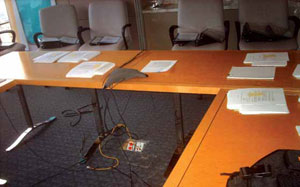How can you Move Cable with That Table?
It can be difficult to manage all the wires, boxes, wall-warts, and power plugs that are often necessary in a conference room setting
When building out a client’s new facility, chances are they will want several different types of conference rooms with as much flexibility as possible. Architects and furniture providers are always eager to please, and there are a number of really amazing reconfigurable furniture systems on the market today. They come with collapsible tables, handy power and data outlets, some cable management, and storage solutions—all good things to have without a doubt. But what they don’t come with is provision for real AV technology.
When I say real AV technology, I mean things like table mics, HDMI input kits, VG A connectors, audio inputs, and control panel ports. All reconfigurable table manufacturers will say that they can accommodate these things, but experience indicates the contrary. Even though there may be physical space to have all these different types of inputs, there’s never an easy way to cable manage all the different types of wires, boxes, wall-warts, and power plugs that are often necessary.
Moreover, the problem is compounded since it’s a good idea to have a mic for every two people if you want to teleconference. That can add up to a lot of wires! Now say you have 24 two-person reconfigurable tables with a mic on each, four HDMI inputs, four VG A inputs, audio lines, power, and data cables for everyone. Complicate things by having a limited budget and pan deck structural accommodation for four floorboxes that are only 3.5 inches deep. No matter how you look at it, you quickly have a cabling nightmare on your hands.
What usually happens is when the furniture is delivered to the site and the project is nearing completion, the AV integrator can finally get into the new room and start wiring up all the tables. A good AV integrator will do a diligent job wiring up the tables so they look great despite all the cabling. Furthermore, if there is teleconferencing capability in the system, a good AV integrator will tune the echo cancellation system for said teleconferencing capability to provide optimal acoustic performance. But the problem is that the room is wired and tuned optimally for this initial table configuration. The first time the room is reconfigured and used in a different configuration, all bets are off. The teleconference system will be out of whack, and chances are the cabling will never look the same.
Now that we’ve clearly identified a growing problem in the AV technology field, the question is: “What can we do about it?” When I begin a project and I’m shown an initial floor plan with reconfigurable tables, I instantly notify my client of the difficulties they will face from a technology standpoint, and recommend against mobile furniture systems. When the client and/or architect quickly shoots down the idea of having fixed furniture systems, several factors must be taken into consideration… a balancing act, if you will.
Balancing Act # 1: Engineer a system that will allow for the simplest setup and breakdown of the technology components slated for integration into reconfigurable furniture systems. This includes the wise placement of the largest floorboxes the deck of your building will support. The more floorboxes you can get, the more cables you can distribute to each one, easing the cable management load through multiple segments of furniture. This will also allow you to distribute more power and data to where it’s needed.
Balancing Act # 2: Develop a system that will feature the most robust teleconferencing technology available today. Build your system around a Polycom, ClearOne, BSS, or Biamp product with serious on-board DSP horsepower for robust echo cancellation. A tabletop Polycom Soundstation with extension mics is not going to suffice in this instance.
Balancing Act # 3: Inform the client what to expect from the usage and performance of the system. Convey your understanding of the system performance to users who drive the need for reconfigurable furniture systems.
Balancing Act # 4: Whenever the room is reconfigured, take extra time to do a professional job dressing and managing cables. Take extra time to test the system for all inputs and teleconferencing quality.
Balancing Act #5: Make sure you budget for a higher level of expenditure when integrating technology in reconfigurable rooms. These rooms will need more switcher inputs, more mic inputs, larger audio routing, and more echo cancelling capabilities. These rooms will also no doubt need a touchpanel-based control system to ease the usage and configuration of the system.
With all these balancing acts, all the extra money, and all the extra effort these rooms require, you’re probably thinking, “No way am I going to do a room like this!” But the reality is that end-users need these rooms, and we are stuck with them.
Because of this, I’m going to issue a call to the AV technology industry: Please develop a solution to this problem in a hurry. A structured cabling system with attachable technology ports for high- and low-voltage signaling is desperately needed. It should be a system that has standardized segments that can be easily attached to the underside of reconfigurable furniture systems. Each low-voltage segment should have anywhere between 100 and 200 conductors that can be assigned to various signals in an equipment rack via a simple-touse punch-down block or similar apparatus. Everything downstream of the punch-down block all the way to the end-user should be modular. It should also possess segments that are easy to pull though a conduit. Maintaining signal integrity will be a challenge, but I have never ceased to be amazed at what the manufacturers of AV technology can develop. AV industry, it’s time to get on it for end-users, consultants, and integrators everywhere!
Joey D’Angelo (joseph.dangelo@cmsalter.com) is a principal consultant at Charles M. Salter Associates. He has worked at Salter for the past 12 years and has completed more than 300 projects since graduating from Cal Poly San Luis Obispo. He enjoys hearing from readers and plays in a punk rock band.
Bretford EDU 2.0
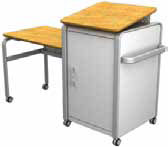
The EDU 2.0 Presentation Shuttle was created with the walk up user in mind by easily allowing a student or instructor to use their personal computer, tablet, or other device with the classroom presentation equipment. Landing work surfaces and data pass through plates are provided for easy plug in access. The upper portion of the cabinet provides a storage space for additional electronics or personal storage and is designed with air circulation in mind to help dissipate heat from equipment when in use. The tower lectern rests at an angle for use with papers, tablets, or computers; it can be adjusted to provide a flat surface for use with projectors or document cameras. Optimal side tables are height adjustable from 26 inches to 32 inches, allowing small children to have their own workspace for presenting.
Chief Music Production Center
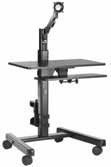
Chief’s pre-configured Music Production Center on Mobile Base Music Production Center system brings recording workstations up to date. These workstations are designed to work with the tools of modern music production—PCs and laptops. Features include a pre-configured mobile base kit with black laminate tabletop and keyboard tray.
HSA Stainless Steel Rolltops
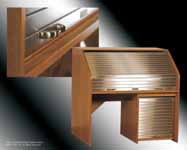
For aesthetics and security, HSA’s Stainless Steel Rolltops are available as an option on many of HSA’s desk and rack models. These heavy-duty, attractive, and fully interlocking secure stainless steel roll-top tambour doors are designed for harsh environments, or simply where the contemporary look of stainless steel is appropriate.
VFI EDU-LE
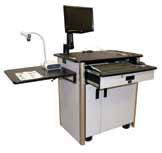
The EDU-LE educational lectern from Video Furniture International features 12 rack spaces and a flip-up shelf, as well as clean audience side look with locking rear access door. Other features include locking front doors, pullout keyboard and mouse tray, removable top surface, 120-millimeter quiet fan, 53CFM ventilation, and 4-inch heavy-duty ball bearing casters. The EDU-LE is constructed from scratch resistant thermal wrap top surface and melamine main body construction.
Middle Atlantic C5 Series Credenza
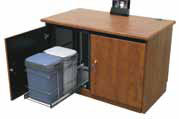
Comprised of a steel rack core and outer wood panels, the C5 can now incorporate many new features based on the requests and feedback of the company’s integration partners. One of the most requested options, monitor mounts, is now available for most 32-inch to 50-inch screens. Shelf system inserts provide space for tableware and supplies and are isolated from the air circulated by the equipment cooling system. Custom cutouts are now possible to accommodate tabletop boxes from all manufacturers for convenient connectivity. C5 credenza racks can also be ordered now with flip up sides that offer additional workspace, including extra room for laptops and portable presentation equipment.
Argosy Mirage
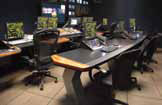
The Mirage technical furniture solution by Argosy combines beauty and function. Each Mirage solution provides an inspirational landscape that allows users to escape the trappings of technology and provides the opportunity to create the best work. The Argosy Mirage solution is properly configured for any screen-based activity— command and control, broadcast, network operations—and rack turrets for ancillary equipment are available. Integrated rack modules accommodate ancillary gear and conceal cabling, which is further concealed and protected inside leg channels.
Forbes AV Multimedia Lectern
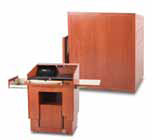
This custom multimedia lectern features a dual working surface finished in black HPL and a builtin motorized lift to control the height. A dropleaf and document-camera drawer provide needed space. The lectern includes a shock mount for a microphone, cutouts for a small monitor and a cable cubby. Cable management holes are included throughout.
Sound-Craft Systems WSV-50
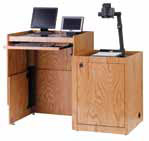
Designed to solve the dilemma of accommodating a variety of instructor teaching styles, the WSV-50 features a heavy-duty manual lift mechanism that raises the unit from a standard, ADA-compliant seated desk position up to a maximum height of 42.5 inches to accommodate standing instructors. A pullout keyboard tray on heavy-duty ball bearing slides is standard. Other features include an integral vented equipment cabinet with a locking door and front access panel, which may be fitted with up to 16 rack unit rails or accessory shelves. Various options and accessories are available to accommodate a range of peripheral equipment.
